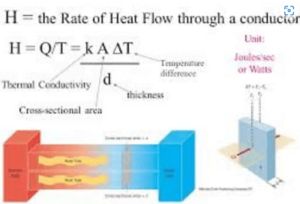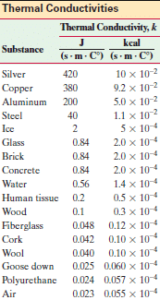What do you mean by Thermal conductivity?
“The rate of flow of heat across the opposite faces of a meter cube of a substance maintained at a temperature difference of one kelvin is called thermal conductivity of that substance.”
What is Thermal conductivity formula?

Conduction of heat occurs at different rates in different materials. In metals, heat flows rapidly as compared to insulators such as wood or rubber. Consider a solid block :
One of its two opposite faces each of cross-sectional area A is heated to temperature T1. Heat Q flows along its length L to the opposite face at temperature T2 in t seconds.
“The amount of heat that flows in unit time is called the rate of flow of heat.”
Thus Rate of flow of heat = Q/t……….(1)
It is observed that the rate at which heat flows through a solid object depends upon various factors.
-
The cross-sectional area of the solid:
Larger cross-sectional area A of a solid contains a larger number of molecules and free electrons on each layer parallel to its cross-sectional area and hence greater will be the rate of flow of heat through the solids. Thus:
Rate of flow of heat Q/t ∝ A …..(2)
-
Length of the solid:
Larger is the length between the hot and cold ends of the solids,more time it will take to conduct heat to the colder end and smaller will be the rate of flow of heat.Thus:
Rate of flow of heat Q/t ∝ 1/L ….(3)
-
Temperature difference between ends
Greater is the temperature difference ( T1 – T2 ) between hot and cold faces of the solids, greater will be the rate of flow of heat. Thus:
Rate of flow of heat is Q/t ∝ ( T1 – T2 )….(4)
Combining the above factors, we get:
Q/t ∝ A ( T1 -T2 ) /L
Rate of flow of heat Q/t =K A ( T1 – T2 )/L …..(5)
Here K i s the proportionality constant called the thermal conductivity of the solids. Its value depends on the nature of the substance and is different for different materials. From above equation (5), we find K as:
K=Q/t ×L/A ( T1 – T2 ) …..(6)
Thermal conductivity examples
Examples of Thermal conductivities of some substances are given in the table:

Stay tuned with oxscience.com for related topics which are given below.
Conduction of heat
Convection of heat
Radiation of heat